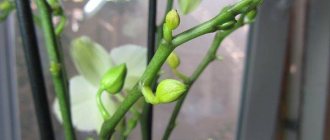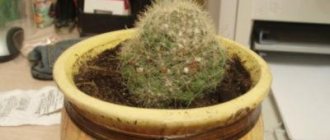Judging by the appearance of the orchid, the plant is already quite mature, and its root system is thoroughly rotten. As a result, the leaves began to wither and turn yellow, since the rotted roots were no longer able to provide them with moisture. However, it is quite possible to save the flower, because the upper part of the main root seems to be still alive. Upon closer inspection, dormant buds should be visible.
To resuscitate an orchid, it is necessary to carry out a number of manipulations:
- thoroughly clean the plant from rotten residues;
- process the flower;
- prepare the pot and substrate;
- plant an orchid.
Why does it rot and why is it dangerous?
Root rotting is associated with improper care. Unfavorable conditions lead to the development of fungi and bacteria on the roots. They penetrate the protective shell and destroy internal cells. A slight violation of care and damage to small roots is enough for the disease to begin to spread throughout the entire root system.
If you do not help the orchid, rotting will destroy the entire root system, which will cause the death of the green pet. To save the plant, it is necessary to eliminate the cause of the disease and carry out therapeutic measures.
If the orchid's immunity is weak, rot can completely destroy the roots in a few days. Therefore, when it is detected, treatment measures must be carried out immediately.
Improper care
Rotting orchids can be caused by various reasons:
- Excessive watering leads to deterioration in the respiration of the roots, they die, and rot appears. Gradually, rotting spreads to large organs.
- Lack of sun reduces the plant's need for moisture, which leads to the same consequences as overwatering.
- A dense substrate impairs root respiration, as does excessive watering. Any mixture becomes compacted over time, which leads to rotting.
- A chemical burn causes damage to the root membrane. It is a consequence of an increase in the concentration of mineral fertilizers in the feeding solution.
- Mechanical damage to the roots due to falling or pests causes the death of part of the root system and “opens the gate” to infections.
To save an orchid, it is necessary to remove the cause of rotting:
- move the plant to a bright, safe place;
- reduce watering;
- change the substrate in a timely manner;
- adhere to the dosage when diluting fertilizers.
Otherwise, treatment measures will not help.
Diseases
Fungi and bacteria cause rot, but they only affect plants if the conditions have been violated. Fungal infections are most often associated with overwatering, especially when there is insufficient lighting.
When watering, moisture enters the velamen, but is not absorbed by the exodermis. A favorable environment is created for the development of fungi. Some species take as little as six hours to begin eating away at the root. The mycelium grows throughout all organs of the orchid, penetrating the stem and leaves.
Many spores of fungi that cause decay are around us. They belong to the natural soil flora. Without overwatering, most fungal organisms are harmless. Only excess moisture makes them dangerous.
Prevention measures
In general, the main reason for root rot is non-compliance with the orchid's watering regime. Accordingly, proper watering is the key to healthy roots and the plant as a whole:
- The influence of moss on the root system. Good moss that retains its structure is useful to the orchid in small quantities. Its excess, combined with waterlogging, can cause moisture stagnation and, ultimately, rot. However, some gardeners manage to successfully keep their orchids in New Zealand moss alone. Obviously, this method requires: Certain skills;
- And experience with orchids.
For orchids, it is necessary to carry out prevention and proper care.
How do you know that the rhizomes have begun to deteriorate and that resuscitation is needed?
Problems with the root system affect the entire plant. Root rot can be suspected based on the following signs:
- the leaves turn yellow, become covered with brown spots, become limp and die one after another;
- buds and flowers quickly fall off;
- The stem wobbles a lot when moving the pot.
If these symptoms appear, you need to check the condition of the root system. To do this, the plant is removed from the pot and inspected:
- Healthy roots have a whitish or greenish color and a dense, elastic texture.
- Rotting leads to changes in color and density. The roots become black or brown and easily crush when pressed. If you run your fingers over the root, your hands will become dirty with a black-brown mass, and all that remains of the root will be an inner vein that looks like a thread.
The importance of foliar feeding
about any fertilizing, including leaf feeding, during the recovery period . You can start feeding carefully only when it is clear that the plant is doing well, the flowers are in place and new root growth has appeared.
On average, the process begins after 1-3 weeks. Then you can feed the orchid leaf by leaf with liquid fertilizers with a focus on nitrogen in a concentration of 1/6 or 1/8 of that indicated on the package, depending on the size of the plant.
Advice! Remember about the possibility of using stimulants and adaptogens, and regularly spray the surface of the plant with water.
Photo
Below you will see what rotten roots look like:
Causes of decay
Every gardener who has had a misfortune with his favorite flower wants to know why the orchid’s roots rot. At home, there can be many reasons for this.
Here they are:
- Improper watering and, as a result, excess moisture lead to the formation of rot on the roots. Inexperienced gardeners often flood the flower. A clear watering schedule is drawn up, adherence to which will prevent a situation where the orchid’s roots begin to rot.
- Infection with fungal diseases also leads to the roots becoming rotten. There is practically no fault of the flower owner here.
- Improper lighting often causes rot. Incorrect summer-winter regime and incorrect location entail such sad consequences.
- Poor quality substrate. The soil chosen for the flower may not be suitable for it at all. It happens that even a good substrate becomes compacted, losing its structure. In this case, aeration of the roots stops.
- Burns of the underground part with fertilizers. This happens when the owner of a flower feeds his plant unwisely.
Important! If the roots are rotting, you need to check the soil.
How to gradually revive a purchased flower that is dying?
How to save an orchid if all its roots are rotten, whether this can be done, and what to do for this, is discussed further. Even if the root system is completely rotten, the plant can be saved. First of all, it is necessary to remove the diseased roots. This is done in several stages.
Substrate removal
- To remove the substrate, the orchid is pulled out of the pot.
- Gently shake the plant until large lumps fall off.
- Residues are removed with water.
Washing the underground part
Before the procedure, the roots are placed in a bowl of water for 10-15 minutes. After this, you can begin the final removal of the substrate:
- The orchid is taken by the stem so that the roots remain in the basin.
- The fingers of the second hand are placed between the roots and gently moved, slightly pushing the woven roots apart.
- Shower off small pieces. To do this, you need to adjust the pressure of the stream so that it does not tear the roots, but cleans off the dirt.
After washing, some roots may still have some substrate left. It cannot be cleaned off by hand. Anything that is not removed with a stream of water is left behind.
Removing diseased roots
What to do with rotting roots? All rotten roots are removed with garden shears or a sharp knife:
- The cut is made on living tissue, at least 3 cm above the lesion site.
- After pruning, the orchid is left in the air for at least 2-3 hours so that the damaged areas heal.
- The dried wound is treated with crushed activated carbon, wood ash or ground cinnamon. This will prevent infection from entering the damaged areas.
After pruning, the orchid can be immediately revived in a greenhouse or in other ways, but it is better to use additional treatment first.
Treatment with growth stimulants
Rotting is always associated with the appearance of a fungus, so before planting, the roots are treated twice, with a week's break. Can be used:
- Tolclofosmethyl.
- Boscalid.
- Pencycuron.
Additionally, succinic acid is added to the solution with each soaking, Epin or Zircon - once every 2-3 weeks.
While antifungal treatment is being carried out, the flower is not planted in the substrate. To prevent the root system from drying out, it is periodically sprayed with a spray bottle. You can add succinic acid to water, 1 tablet per liter of water, it is a natural and safe growth stimulator.
When reviving without a substrate, you can combine root germination and treatment with fungicides and biostimulants.
Method of growing the root system in water
If the roots are in the process of rotting, but there are still leaves, the easiest way to save the plant is to grow the root system in water. To do this, remove damaged shoots, treat with ash and dry for 1–2 hours. Treat the roots with chemicals to prevent recurrence of the disease.
Popular products are Intra-Vir, Aktara, Vermitek and other drugs that help save the roots of the plant. Flower growers advise keeping only the tip of the plant in water and systematically renewing the water. After 2 months, new roots will appear.
Orchid after transplantation: 5 rules of care
How to care for it to preserve it?
When revived by any method, the plants are provided with ideal environmental conditions: twelve-hour daylight hours, diffused lighting and an air temperature of 20-27 degrees. During the period of root system restoration:
- Reduce the amount of nitrogen in fertilizing.
- If the flower lacks moisture and the leaves lose turgor, they are sprayed.
- Provide regular but meager watering.
In a favorable environment, the orchid will begin to grow roots almost immediately after transplantation. Small flowers will restore the root system in 2-3 months, large specimens will need about six months. Until the plant's health is restored, it will not grow or bloom.
Caring for an orchid after “revival”
After revitalizing the orchid's root system, you need to replant its substrate, the basis of which consists of bark.
Caring for a lively orchid is no different from caring for a regular plant. The main thing is to protect the crop from direct sunlight, ensure high air humidity and not flood the soil. The next watering can be carried out only after the top layer of soil has dried.
It is also necessary to regularly inspect the plant for damage by pests and diseases and promptly begin resuscitation actions. Affected crops must be quarantined.











